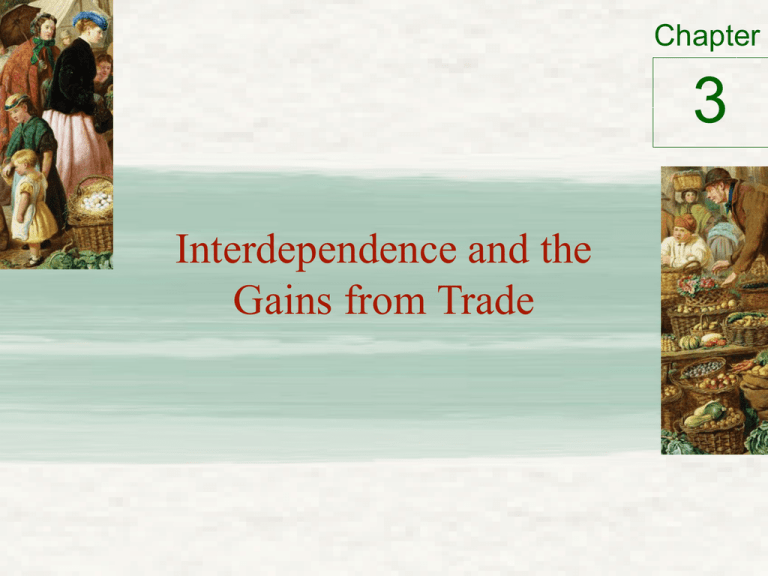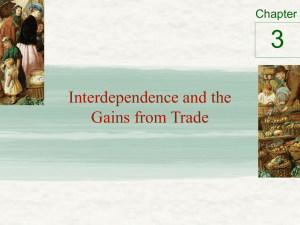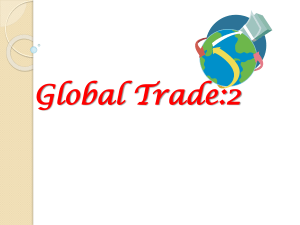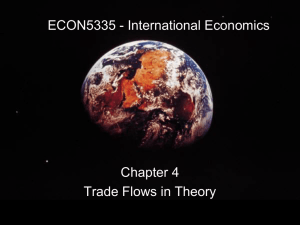3 Interdependence and the Gains from Trade Chapter
advertisement

Chapter 3 Interdependence and the Gains from Trade Why Trade – PPF Model of Trade • DEFINITION of 'Production Possibility Frontier - PPF' A curve depicting all maximum output possibilities for two or more goods given a set of inputs (resources, labor, etc.). The PPF assumes that all inputs are used efficiently. • A production-possibility frontier is a budget constraint presented by the limitation of available factors of production. 2 • The production--possibility frontier (PPF) is an expository figure for representing scarcity, cost, and efficiency. 3 How People Interact Chapter Principle 5: Trade can make everyone better off • Trade – Specialization • Allows each person/country to specialize in the activities he/she does best – People/countries can buy a greater variety of goods and services at lower cost 4 A Parable for the Modern Economy • Two goods: meat and potatoes • Two people: rancher and farmer • If rancher produces only meat – And farmer produces only potatoes – Both gain from trade • If both rancher and farmer produce both meat and potatoes – They still gain from specialization and trade 5 Figure 1 The production possibilities frontier (a) (a) Production Opportunities Minutes needed to Make 1 ounce of: Farmer Rancher Amount produced in 8 hours Meat Potatoes Meat Potatoes 60 min/oz 20 min/oz 15 min/oz 10 min/oz 8 oz 24 oz 32 oz 48 oz Panel (a) shows the production opportunities available to the farmer and the rancher. 6 Figure 1 The production possibilities frontier (b, c) (b) The farmer’s production Meat (oz) possibilities frontier If there is no trade, the farmer chooses this production and consumption. (c) The rancher’s production Meat (oz) possibilities frontier 24 8 12 4 0 If there is no trade, the rancher chooses this production and consumption. B A 16 Potatoes (oz) 32 0 24 48 Potatoes (oz) Panel (b) shows the combinations of meat and potatoes that the farmer can produce. Panel (c) shows the combinations of meat and potatoes that the rancher can produce. Both production possibilities frontiers are derived assuming that the farmer and rancher each work 8 hours per day. If there is no trade, each person’s production possibilities frontier is also his or her consumption possibilities frontier 7 Figure 1 The opportunity cost of meat and potatoes Opportunity cost of: Farmer Rancher 1 oz of Meat 1 oz of Potatoes 4 oz potatoes 2 oz potatoes ¼ oz meat ½ oz meat 8 A Parable for the Modern Economy • Specialization and trade – Farmer – specialize in growing potatoes • More time growing potatoes • Less time raising cattle – Rancher – specialize in raising cattle • More time raising cattle • Less time growing potatoes – Trade • Willing to trade: 3 oz of meat for 1 oz potatoes • Final trade -5 oz of meat for 15 oz of potatoes 9 Farmer’s Gains From Trade Farmer Potatoes Meat No Trade With 32 32 0 28 29 1 24 26 2 20 23 3 16 20 4 12 17 5 8 14 6 4 11 7 0 8 8 35 30 25 20 Taters - No Trade 15 Taters - Trade 10 5 0 0 1 2 3 4 5 6 7 8 10 Rancher’s Gains From Trade 80 70 60 50 Taters - No Trade 40 Taters - Trade 30 20 10 0 24 22 20 18 16 14 12 10 8 6 4 2 0 11 Figure 2 Greg’s Final Solution (text) (a) The farmer’s production Meat (oz) and consumption Farmer's production and consumption without trade 8 Farmer's consumption with trade 0 A 16 17 Farmer's production with trade 32 18 B* 13 12 0 Rancher’s production and consumption without trade Rancher’s production with trade 24 A* 5 4 (b) The rancher’s production Meat (oz) and consumption Rancher’s consumption with trade B 12 27 24 48 Potatoes (oz) Potatoes (oz) Farmer and Rancher agree to trade 5 oz of Meat for 15 oz of Potatoes (3:1) Start at corners (specialization) 12 Figure 2 How trade expands the set of consumption opportunities (c) (c) The gains from trade: A summary Farmer Without trade: Production and consumption With trade: Production Trade Consumption GAINS FROM TRADE: Increase in consumption Rancher Meat Potatoes Meat Potatoes 4 oz 16 oz 12 oz 24 oz 0 oz Gets 5 oz 5 oz 32 oz Gives 15 oz 17 oz +1 oz +1 oz 18 oz 12 oz Gives 5 oz Gets 15 oz 13 oz 27 oz +1 oz +3 oz 13 Comparative Advantage • Absolute advantage – Produce a good using fewer inputs than another producer – Rancher: 20 min/1 oz M; 10 min/1 oz P – Farmer: 60 min/ 1 oz M; 15 min/ 1 oz P • Opportunity cost – Measures the trade-off between the two goods that each producer faces – Rancher -1 oz M -> 2 oz P – Farmer: 3 oz P -> -1 oz M 14 Table 1 The opportunity cost of meat and potatoes Opportunity cost of: Farmer Rancher 1 oz of Meat 1 oz of Potatoes 4 oz potatoes 2 oz potatoes ¼ oz meat ½ oz meat 15 Comparative Advantage • Comparative advantage – Produce a good - lower opportunity cost than another producer – Reflects - relative opportunity cost • Principle of comparative advantage – Each good - produced by the individual that has the smaller opportunity cost of producing that good 16 Comparative Advantage • One person – Can have absolute advantage in both goods – Cannot have comparative advantage in both goods • For different opportunity costs – One person - comparative advantage in one good – The other person - comparative advantage in the other good 17 Comparative Advantage • Opportunity cost of one good – Inverse of the opportunity cost of the other • Gains from specialization and trade – Based on comparative advantage – Total production in economy rises • Increase in the size of the economic pie • Everyone – better off 18 Comparative Advantage • Trade can benefit everyone in society – Allows people to specialize in activities • Have a comparative advantage • The price of trade – Must lie between the two opportunity costs • Principle of comparative advantage explains: – Interdependence – Gains from trade 19 Applications of Comparative Advantage • Should the U.S. trade with other countries? – Imports • Goods produced abroad and sold domestically – Exports • Goods produced domestically and sold abroad • Principle of comparative advantage – Each good – produced by the country • Smaller opportunity cost of producing that good • Specialization and trade • All countries – greater prosperity 20




